Europe was an interesting market for the Paramount studios. During the silent era, there was a close connection between the Ufa in Berlin and Paramount. In the early sound period, Paramount built a special studio near Paris, where many multi-language films were produced during the early 1930s. During the 1920s, 'Édition Paramount' in Paris published a series of postcards of Paramount stars for the French fans. This sepia-tinted series was called ... des Films Paramount.

French postcard by Édition Paramount, Paris.
American comedian Roscoe ‘Fatty’ Arbuckle (1887-1933) was one of the most popular silent stars of the 1910s. He started at the Selig Polyscope and moved to Keystone Studios, where he worked with Mabel Normand and Harold Lloyd. Arbuckle mentored Charlie Chaplin and discovered Buster Keaton and Bob Hope. In 1920, he signed a contract with Paramount Pictures for US$ 1 million. Between November 1921 and April 1922, Arbuckle was the defendant in three widely publicised trials for the rape and manslaughter of actress Virginia Rappe. Following the trials, his films were banned and he was publicly ostracised. Arbuckle only later worked as a film director under the alias William Goodrich. He was finally able to return to acting, making short two-reel comedies in 1932 for Warner Bros. He died in his sleep of a heart attack in 1933 at age 46, reportedly on the same day he signed a contract with Warner Brothers to make a feature film.

French postcard by Édition Paramount, Paris.
Agnes Ayres (1898-1940) was an American film actress. After her debut with Chaplin and acting at Essanay and Fox, she had her breakthrough in The Sheik (1921) with Rudolph Valentino. Several important parts at Paramount followed in e.g. The Affairs of Anatol (1921) and The Ten Commandments (1923). After a dip in the mid-1920s, she had her comeback in The Son of the Sheik (1926), but the arrival of sound cinema made an end to her career.

French postcard by Édition Paramount, Paris.
Enid Bennett (1893–1969) was an Australian silent film actress, mostly active in American film. She peaked in the late 1910s and early 1920s with films such as Robin Hood (1922), starring Douglas Fairbanks. In 1931 she played Jackie Coogan's mother in the Oscar-winning film Skippy. She was the wife of director Fred Niblo and after his death, she married director Sidney Franklin.

French postcard by Édition Paramount, Paris.
American actress Billie Burke (1884–1970) is now primarily known as Glinda the Good Witch of the North in The Wizard of Oz (Victor Fleming, 1939), but she had an impressive career both on stage and in the cinema, in Britain and the US.
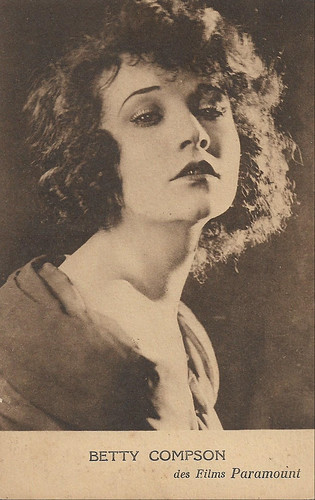
French postcard by Édition Paramount, Paris.
American actress and film producer Betty Compson (1897–1974) peaked in the silent cinema and the early talkies. She is best known for her performances as a suicidal prostitute rescued by a stoker (George Bancroft) in The Docks of New York (Joseph Von Sternberg, 1928), and as the manipulative carnival girl Carrie in the part-talkie The Barker (George Fitzmaurice, 1928), the latter earning her a nomination for the Academy Award for Best Actress.
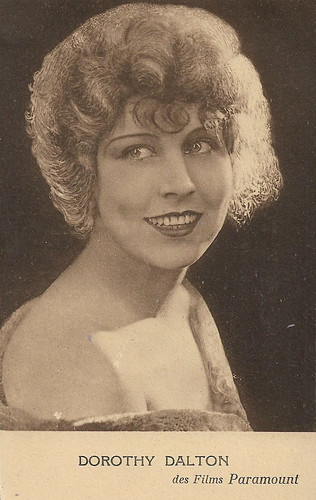
French postcard by Édition Paramount, Paris.
Dorothy Dalton (1893-1972) was an American actress, who was highly popular in the silent era. She worked for Kay-Bee, Thomas Ince Corp., and Famous Players (Paramount), but left the film sets in 1924 when she married theatre producer Arthur Hammerstein.
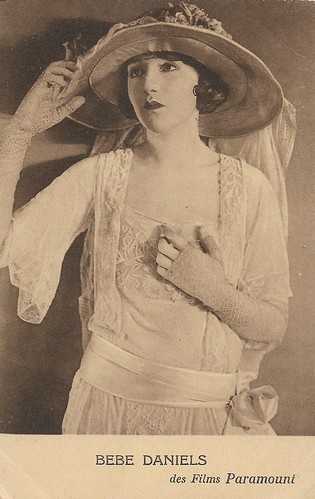
French postcard by Édition Paramount, Paris.
Bebe Daniels (1901-1971) began her career in Hollywood during the silent film era as a child actress. She later became the love interest of Harold Lloyd in dozens of short comedies. Cecil B. de Mille made her a silent star and later she sang and danced in early musicals like Rio Rita (1929) and 42nd Street (1933). In Great Britain, she gained further fame on stage, radio, and television. In her long career, Bebe Daniels appeared in 230 films.
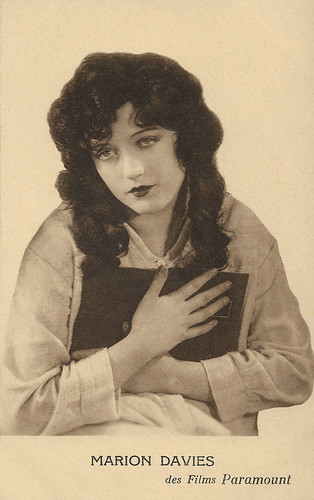
French postcard by Édition Paramount, Paris. Photo: Marion Davies in The Bride's Play (George Terwilliger, 1922).
Marion Davies (1897-1961) was one of the great comedic actresses of the silent era. She starred in nearly four dozen films between 1917 and 1937.

French postcard by Édition Paramount, Paris.
William Surrey Hart (1864–1946) was an American silent film actor, screenwriter, director, and producer. He entered films in 1914 where, after playing supporting roles in two short films, he achieved stardom as the lead in The Bargain (Reginald Barker, 1914), his first Western. He became a foremost Western star of the silent era who played characters with honour and integrity. Hart was particularly interested in making realistic Westerns, and his films are noted for their authentic costumes and props. Hart also had an extraordinary acting ability, honed on Shakespearean theatre stages in the United States and England.

French postcard by Édition Paramount, Paris.
Jack Holt (1888–1951), was an American film actor in both silent and sound movies, particularly in Westerns.

French postcard by Édition Paramount, Paris.
Lila Lee (1901–1973) was a prominent screen actress, primarily a leading lady, of the silent film and early sound film eras.

French postcard by Édition Paramount, Paris.
American silent film actor Douglas MacLean (1890–1967) acted in many romantic comedies, and was known as 'The Man With the Million Dollar Smile'. MacLean started in the pictures in 1914, acted opposite Alice Brady, Mary Pickford, and Dorothy Gish. After some 25 films for various companies, he worked for Paramount and First National between 1922 and 1929. In the 1930s, he produced films for Paramount and afterward was a freelance writer for film and television.

French postcard by Édition Paramount, Paris.
May McAvoy (1899-1984), also written as MacAvoy and Mac Avoy, was an American actress of the silent screen, best known as Esther in the classic epic Ben-Hur (Fred Niblo, 1925).

French postcard by Édition Paramount, Paris.
Thomas Meighan (1879-1936) was an American stage and screen actor, noted for his films with directors William and Cecil B. DeMille.

French postcard by Édition Paramount, Paris.
Spanish diva Raquel Meller (1888-1962) was already a highly popular singer before debuting as a film actress in 1919. She performed not only in Spain but also in France and the USA.

French postcard by Édition Paramount, Paris.
American actor Conrad Nagel (1897-1970) was a tall, blue-eyed matinee idol of the 1920s. He successfully made the transition to sound film.

French postcard by Édition Paramount, Paris.
American silent film actor Wallace Reid (1891–1923) was 'the screen's most perfect lover'. Born in a vaudeville family, he became an all-around athlete and a gifted musician. When his father entered the film business in 1910, he brought along his teenage son, who debuted at Selig but soon rose to popularity at Vitagraph. After some 100 shorts and parts in films like Birth of a nation and Intolerance by D.W. Griffith, Paramount hired him for some 60 more films. By the 1920s, Reid was one of Hollywood's major heartthrobs. En route to Oregon for a film shooting in 1919, he was injured in a train wreck and took morphine to continue filming. This led to an addiction, which in 1923 killed him, at the age of only 31.

French postcard by Édition Paramount, Paris.
Theodore Roberts (1861–1928) was an American stage and screen actor, who is known for his many parts in films by Cecil B. DeMille and his brother William.

French postcard by Édition Paramount, Paris.
Gloria Swanson (1899-1983) was one of the biggest Hollywood stars of the silent era. She transformed from a typical Mack Sennett comedienne into a lively, provocative, even predatory, star in films by Cecil B. De Mille. She received Oscar nominations for Sadie Thompson (1928), The Trespasser (1929), and Sunset Blvd. (1950).

French postcard by Édition Paramount, Paris. Rudolph Valentino in The Sheik (George Melford, 1921).
Rudolph Valentino (1895-1926) was Hollywood's ultimate 'Latin Lover'. The Italian-born American actor starred in several well-known silent films including The Four Horsemen of the Apocalypse (1921), The Sheik (1921), Blood and Sand (1922), The Eagle (1925), and The Son of the Sheik (1926). His early death at age 31 caused mass hysteria among his female fans and propelled him into iconic status.

French postcard by Édition Paramount, Paris.
American film actor Bryant Washburn (1889–1963) appeared in 375 films between 1911 and 1947. From 1911, he was one of the leading actors of the Essanay company. He quickly became a comedy star after appearing in films such as Skinner's Baby and Skinner's Dress Suit in 1917. In 1918 he moved over to Paramount/Famous Players-Lasky. In the 1910s and the early 1920s, he was one of the most popular American actors. From the mid-1920s he played supporting parts and managed to continue so well into the sound era.
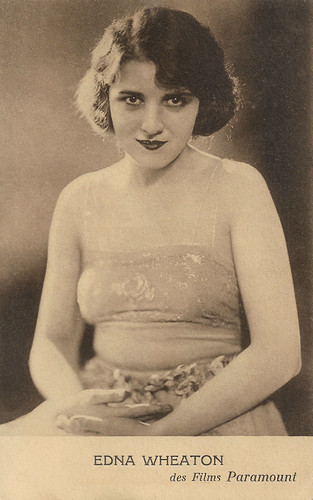
French postcard by Édition Paramount, Paris. Photo: Films Paramount.
American dancer and actress Edna Wheaton (1882-1967) was the star of only one film, the Paramount production Experience (George Fitzmaurice, 1921). She appeared as Beauty while co-stars Richard Barthelmess played Youth, Lilyan Tashman played Pleasure and Nita Naldi played Temptation. The title role, Experience, was performed by John Miltern.

French postcard by Édition Paramount, Paris.
American comedian Roscoe ‘Fatty’ Arbuckle (1887-1933) was one of the most popular silent stars of the 1910s. He started at the Selig Polyscope and moved to Keystone Studios, where he worked with Mabel Normand and Harold Lloyd. Arbuckle mentored Charlie Chaplin and discovered Buster Keaton and Bob Hope. In 1920, he signed a contract with Paramount Pictures for US$ 1 million. Between November 1921 and April 1922, Arbuckle was the defendant in three widely publicised trials for the rape and manslaughter of actress Virginia Rappe. Following the trials, his films were banned and he was publicly ostracised. Arbuckle only later worked as a film director under the alias William Goodrich. He was finally able to return to acting, making short two-reel comedies in 1932 for Warner Bros. He died in his sleep of a heart attack in 1933 at age 46, reportedly on the same day he signed a contract with Warner Brothers to make a feature film.

French postcard by Édition Paramount, Paris.
Agnes Ayres (1898-1940) was an American film actress. After her debut with Chaplin and acting at Essanay and Fox, she had her breakthrough in The Sheik (1921) with Rudolph Valentino. Several important parts at Paramount followed in e.g. The Affairs of Anatol (1921) and The Ten Commandments (1923). After a dip in the mid-1920s, she had her comeback in The Son of the Sheik (1926), but the arrival of sound cinema made an end to her career.

French postcard by Édition Paramount, Paris.
Enid Bennett (1893–1969) was an Australian silent film actress, mostly active in American film. She peaked in the late 1910s and early 1920s with films such as Robin Hood (1922), starring Douglas Fairbanks. In 1931 she played Jackie Coogan's mother in the Oscar-winning film Skippy. She was the wife of director Fred Niblo and after his death, she married director Sidney Franklin.

French postcard by Édition Paramount, Paris.
American actress Billie Burke (1884–1970) is now primarily known as Glinda the Good Witch of the North in The Wizard of Oz (Victor Fleming, 1939), but she had an impressive career both on stage and in the cinema, in Britain and the US.

French postcard by Édition Paramount, Paris.
American actress and film producer Betty Compson (1897–1974) peaked in the silent cinema and the early talkies. She is best known for her performances as a suicidal prostitute rescued by a stoker (George Bancroft) in The Docks of New York (Joseph Von Sternberg, 1928), and as the manipulative carnival girl Carrie in the part-talkie The Barker (George Fitzmaurice, 1928), the latter earning her a nomination for the Academy Award for Best Actress.

French postcard by Édition Paramount, Paris.
Dorothy Dalton (1893-1972) was an American actress, who was highly popular in the silent era. She worked for Kay-Bee, Thomas Ince Corp., and Famous Players (Paramount), but left the film sets in 1924 when she married theatre producer Arthur Hammerstein.

French postcard by Édition Paramount, Paris.
Bebe Daniels (1901-1971) began her career in Hollywood during the silent film era as a child actress. She later became the love interest of Harold Lloyd in dozens of short comedies. Cecil B. de Mille made her a silent star and later she sang and danced in early musicals like Rio Rita (1929) and 42nd Street (1933). In Great Britain, she gained further fame on stage, radio, and television. In her long career, Bebe Daniels appeared in 230 films.

French postcard by Édition Paramount, Paris. Photo: Marion Davies in The Bride's Play (George Terwilliger, 1922).
Marion Davies (1897-1961) was one of the great comedic actresses of the silent era. She starred in nearly four dozen films between 1917 and 1937.

French postcard by Édition Paramount, Paris.
William Surrey Hart (1864–1946) was an American silent film actor, screenwriter, director, and producer. He entered films in 1914 where, after playing supporting roles in two short films, he achieved stardom as the lead in The Bargain (Reginald Barker, 1914), his first Western. He became a foremost Western star of the silent era who played characters with honour and integrity. Hart was particularly interested in making realistic Westerns, and his films are noted for their authentic costumes and props. Hart also had an extraordinary acting ability, honed on Shakespearean theatre stages in the United States and England.

French postcard by Édition Paramount, Paris.
Jack Holt (1888–1951), was an American film actor in both silent and sound movies, particularly in Westerns.

French postcard by Édition Paramount, Paris.
Lila Lee (1901–1973) was a prominent screen actress, primarily a leading lady, of the silent film and early sound film eras.

French postcard by Édition Paramount, Paris.
American silent film actor Douglas MacLean (1890–1967) acted in many romantic comedies, and was known as 'The Man With the Million Dollar Smile'. MacLean started in the pictures in 1914, acted opposite Alice Brady, Mary Pickford, and Dorothy Gish. After some 25 films for various companies, he worked for Paramount and First National between 1922 and 1929. In the 1930s, he produced films for Paramount and afterward was a freelance writer for film and television.

French postcard by Édition Paramount, Paris.
May McAvoy (1899-1984), also written as MacAvoy and Mac Avoy, was an American actress of the silent screen, best known as Esther in the classic epic Ben-Hur (Fred Niblo, 1925).

French postcard by Édition Paramount, Paris.
Thomas Meighan (1879-1936) was an American stage and screen actor, noted for his films with directors William and Cecil B. DeMille.

French postcard by Édition Paramount, Paris.
Spanish diva Raquel Meller (1888-1962) was already a highly popular singer before debuting as a film actress in 1919. She performed not only in Spain but also in France and the USA.

French postcard by Édition Paramount, Paris.
American actor Conrad Nagel (1897-1970) was a tall, blue-eyed matinee idol of the 1920s. He successfully made the transition to sound film.

French postcard by Édition Paramount, Paris.
American silent film actor Wallace Reid (1891–1923) was 'the screen's most perfect lover'. Born in a vaudeville family, he became an all-around athlete and a gifted musician. When his father entered the film business in 1910, he brought along his teenage son, who debuted at Selig but soon rose to popularity at Vitagraph. After some 100 shorts and parts in films like Birth of a nation and Intolerance by D.W. Griffith, Paramount hired him for some 60 more films. By the 1920s, Reid was one of Hollywood's major heartthrobs. En route to Oregon for a film shooting in 1919, he was injured in a train wreck and took morphine to continue filming. This led to an addiction, which in 1923 killed him, at the age of only 31.

French postcard by Édition Paramount, Paris.
Theodore Roberts (1861–1928) was an American stage and screen actor, who is known for his many parts in films by Cecil B. DeMille and his brother William.

French postcard by Édition Paramount, Paris.
Gloria Swanson (1899-1983) was one of the biggest Hollywood stars of the silent era. She transformed from a typical Mack Sennett comedienne into a lively, provocative, even predatory, star in films by Cecil B. De Mille. She received Oscar nominations for Sadie Thompson (1928), The Trespasser (1929), and Sunset Blvd. (1950).

French postcard by Édition Paramount, Paris. Rudolph Valentino in The Sheik (George Melford, 1921).
Rudolph Valentino (1895-1926) was Hollywood's ultimate 'Latin Lover'. The Italian-born American actor starred in several well-known silent films including The Four Horsemen of the Apocalypse (1921), The Sheik (1921), Blood and Sand (1922), The Eagle (1925), and The Son of the Sheik (1926). His early death at age 31 caused mass hysteria among his female fans and propelled him into iconic status.

French postcard by Édition Paramount, Paris.
American film actor Bryant Washburn (1889–1963) appeared in 375 films between 1911 and 1947. From 1911, he was one of the leading actors of the Essanay company. He quickly became a comedy star after appearing in films such as Skinner's Baby and Skinner's Dress Suit in 1917. In 1918 he moved over to Paramount/Famous Players-Lasky. In the 1910s and the early 1920s, he was one of the most popular American actors. From the mid-1920s he played supporting parts and managed to continue so well into the sound era.

French postcard by Édition Paramount, Paris. Photo: Films Paramount.
American dancer and actress Edna Wheaton (1882-1967) was the star of only one film, the Paramount production Experience (George Fitzmaurice, 1921). She appeared as Beauty while co-stars Richard Barthelmess played Youth, Lilyan Tashman played Pleasure and Nita Naldi played Temptation. The title role, Experience, was performed by John Miltern.
No comments:
Post a Comment